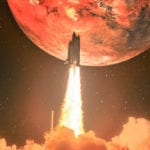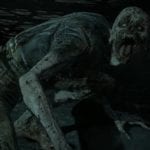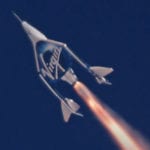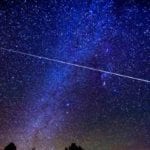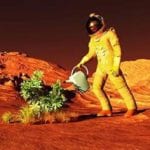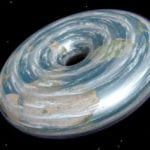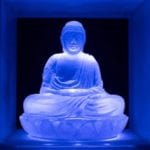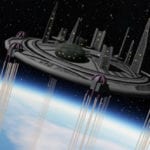 Animals
Animals  Animals
Animals  Weird Stuff
Weird Stuff 10 Weird Things People Used to Do at New Year’s
 Our World
Our World 10 Archaeological Discoveries of 2025 That Refined History
 Weird Stuff
Weird Stuff 10 Fascinating Facts You Might Not Know About Snow
 Miscellaneous
Miscellaneous Top 10 Things Crypto Was Supposed to Change & What Actually Did
 History
History 10 Huge Historical Events That Happened on Christmas Eve
 Music
Music 10 Surprising Origin Stories of Your Favorite Holiday Songs
 History
History 10 Less Than Jolly Events That Occurred on December 25
 Weird Stuff
Weird Stuff 10 Funny Ways That Researchers Overthink Christmas
 Politics
Politics 10 Political Scandals That Sent Crowds Into the Streets
 Animals
Animals 10 Species That Refused to Go Extinct
 Weird Stuff
Weird Stuff 10 Weird Things People Used to Do at New Year’s
 Our World
Our World 10 Archaeological Discoveries of 2025 That Refined History
Who's Behind Listverse?

Jamie Frater
Head Editor
Jamie founded Listverse due to an insatiable desire to share fascinating, obscure, and bizarre facts. He has been a guest speaker on numerous national radio and television stations and is a five time published author.
More About Us Weird Stuff
Weird Stuff 10 Fascinating Facts You Might Not Know About Snow
 Miscellaneous
Miscellaneous Top 10 Things Crypto Was Supposed to Change & What Actually Did
 History
History 10 Huge Historical Events That Happened on Christmas Eve
 Music
Music 10 Surprising Origin Stories of Your Favorite Holiday Songs
 History
History 10 Less Than Jolly Events That Occurred on December 25
 Weird Stuff
Weird Stuff 10 Funny Ways That Researchers Overthink Christmas
 Politics
Politics 10 Political Scandals That Sent Crowds Into the Streets
10 Joys And Terrors Of Space Exploration
The dangers of space travel are well understood. Lists of its casualties include the entire Apollo 1 crew (Gus Grissom, Edward White II, Roger Chaffee) and the entire team of cosmonauts on the Soyuz 11 (Georgi Dobrovolski, Viktor Patsayev, Vladislav Volkov). The business of space travel is a risky one. Since the 1960s, more than 20 astronauts and cosmonauts have died in the pursuit of space exploration.
But that’s only one piece of the puzzle. Sally Ride, the first American woman in space, summed up the other half when she said, “The thing I’ll remember most about the flight is that it was fun. In fact, I’m sure it was the most fun that I’ll ever have in my life.”
Space exploration is equal parts danger and excitement, sprinkled with humor. The following are five cases of the harrowing nature of space flight and five cases of its goofiness.
10 Terror: Blinded During A Spacewalk
The very notion of a spacewalk, or EVA (extravehicular activity), is a terrifying one in which the astronaut leaves the confines and safety of his ship or station with only a tether to keep him from drifting into infinite nothingness. Particularly terrifying would be losing one of your most important senses during the venture. This is exactly what happened to Commander Chris Hadfield during a spacewalk in 2001.[1]
During such a spacewalk, keeping an uninterrupted view is important for efficiency. So, an oil-and-soap solution is used to coat the inside of the spacesuit visor to prevent fogging. In an incredible irony, that solution was responsible for totally removing Hadfield’s ability to see.
Sweat or tears managed to come into contact with the solution and floated directly into Hadfield’s eye, which caused instant blindness as his eye began to tear up. Hadfield said, “I thought, well, I—maybe that’s why we have two eyes. So I kept working.”
With his one eye temporarily blinded, tearing up would normally be perfectly fine. After all, tears are our eyes’ means to clean themselves. But in the microgravity of orbit, the tears wouldn’t fall down Hadfield’s face.
Instead, they pooled up in a ball around his eye, a blob that eventually became so large that it spread to his other eye. He was completely blind, floating along with the world in outer space and alone outside of his spaceship.
Hadfield relied on his training and trusted his crew. Given enough time, his body produced sufficient tears to dilute the antifog solution and he was able to see through the puddle. After some negotiation with Houston, he was even able to continue working and finish his task.
Explaining the key to keeping calm even in situations as nerve-racking as that one, Hadfield said:
[It’s] looking at the difference between perceived danger and actual danger. Where is the real risk? Where is the real thing that you should be afraid of? Not just a generic fear of bad things happening. You can fundamentally change your reaction to things. It allows you to go places and see things and do things that would otherwise be completely denied to you.
9 Joy: A Music Video In Space
Not all of Commander Hadfield’s experiences in space were harrowing ordeals. He also found the time to work on a “family project” with his son. Namely, they recorded footage of the commander singing and playing “Space Oddity” by David Bowie with the International Space Station’s own guitar and edited it into a music video, the first ever made in space.
The guitar was transported to the ISS by Space Shuttle Discovery in 2001. Later instrument additions to the ISS included a flute, a keyboard, a saxophone, and an Australian didgeridoo.
Hadfield discussed David Bowie’s reaction to the video and said:
He described it as the most poignant version of the song ever done, which just floored me. I think, for him, he knew he was ill—it was getting to the end of his life. He wrote that song at the beginning, when he was still 19 or 20, before we had even walked on the Moon.
He had always fantasized about flying in space—Starman and Mars and all that other stuff, and I think for him it was just like a gift, to have that song updated with the lyrics, performed actually in space, just a couple of years before he was taken. To me, that might be the best part—that he got delight out of my particular version of the song.[2]
8 Terror: Nearly Drowning In Space
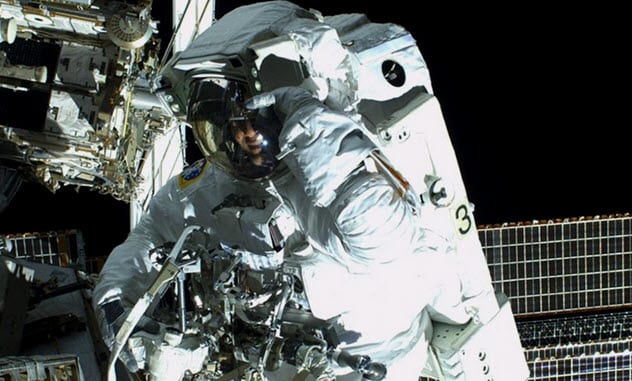
Approximately 385 kilometers (240 mi) away from any ocean, lake, pond, creek, or pool, one would think that a fear of drowning could be safely ignored while serving aboard the International Space Station. Astronaut Luca Parmitano faced this danger during a spacewalk in July 2013 when he began to feel liquid pooling at the back of his head in his spacesuit.
He was sweating, he concluded, but not enough to account for what he was feeling. He tasted a droplet of the water. It was metallic and very cold, not at all like the drinking water available inside his suit.
After Parmitano consulted with his crew and mission control, the spacewalk was canceled. It wasn’t a hasty dash back to the station. Instead, they were given instructions to make an orderly withdrawal.
However, the two astronauts on the spacewalk had to take different routes to return to the airlock or their tethers would risk getting tangled. Luca Parmitano made his way back alone, with a helmet slowly filling with a mystery liquid.
During his walk back to the airlock, he needed to flip his body to avoid an obstacle. Due to that motion, the growing blob of zero-gravity water moved into his eyes and nostrils. He was blinded and fighting to breathe. At this point, his headset stopped working. He said, “I’ve been told that I was cool as a cucumber. The truth is that I was trying to talk.”
It took Parmitano 24 minutes to get inside and 11 minutes more to get his suit off. Inside the airlock as he waited for air to pressurize the chamber, he said:
[I] was just waiting for the [repressurization] to end, taking it one second at a time. At that point, I’m virtually isolated from a sensory point of view. I can’t hear. I can’t really see. I can’t move. Every time I moved, the water sloshed around.
Astronaut Chris Cassidy was Parmitano’s partner during the spacewalk. Describing when they were in the airlock together, Cassidy said:
[The water was] sort of bouncing around his nostrils. That’s when my senses really got heightened. So I grabbed his hand, just kind of squeezing it. He and I had never talked before that this would be our hand signal if we can’t talk. It just was a natural thing. I grabbed his hand and squeezed it. He squeezed it back, so I knew he was okay.[3]
Cassidy then reported, “He looks fine. He looks miserable but okay.”
After Parmitano’s helmet was removed and the liquid mopped off, it amounted to an estimated 1.4 liters (1.5 qt). The source of the water was from a failed fan pump separator. Since the incident, a snorkel-like addition has been fitted to spacesuits, giving astronauts a way to breathe if their suits fill with water.
7 Joy: Smuggling Sandwiches Into Space
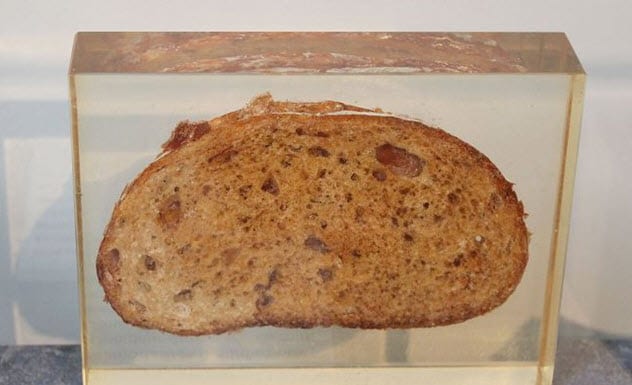
During the early NASA space missions, food was bland and tasteless, which left some astronauts craving something more. One astronaut in particular, John Young, took matters into his own hands and brought a corned beef sandwich with him on the Gemini 3 mission.
It was the first American two-man spaceflight, and he naturally offered a bite to his fellow astronaut Gus Grissom. The Gemini 3 transcript recorded the entire conversation:
“What is it?” Grissom asked.
“Corned beef sandwich,” Young replied.
“Where did that come from?”
“I brought it with me. Let’s see how it tastes. Smells, doesn’t it?”
Grissom took Young up on his offer to try some and then quickly put the sandwich away because the rye bread was falling apart as he ate it. Crumbs started to fill the cabin. Young admitted that the sandwich was “a thought . . . not a very good one.” Grissom stayed positive about it. “Pretty good, though,” he said, “if it would just hold together.”
All told, the conversation lasted less than a minute, but that sandwich caused Young to receive some heat from the US House of Representatives’ Committee on Appropriations. They called it the $30 million sandwich. George Mueller, NASA’s associate administrator for manned space flight, made the agency’s position on unofficial sandwiches clear when he said, “We have taken steps . . . to prevent recurrence of corned beef sandwiches in future flights.”
Despite those words, corned beef sandwiches were included officially in food offered to astronauts in April 1981. Perhaps it wasn’t coincidental that they first appeared on the menu on a shuttle mission commanded by Young.[4]
6 Terror: Ballistic Landings
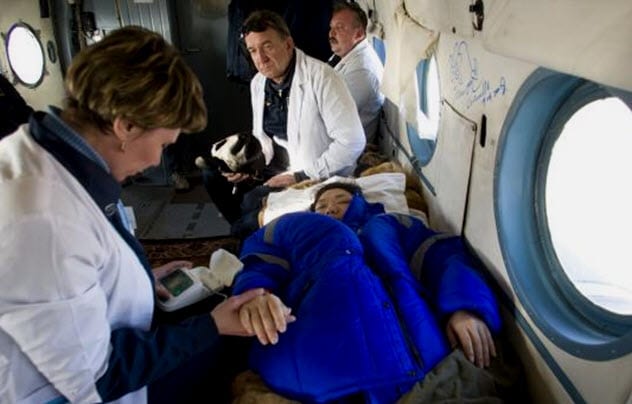
You may have heard the term “controlled descent.” It is a flat flight profile descent to Earth which doesn’t put much strain on a vehicle (or pilots). It’s like a paper airplane glide, slowly losing altitude until it lands on the ground. A controlled descent is the ideal way to land a spaceship like a Russian Soyuz capsule, which is used to ferry cosmonauts and astronauts back from the ISS.
The opposite of a controlled descent is a ballistic reentry. This is a harsh, steep drop back to Earth. It puts much more strain on the craft and its occupants.
In the event of a ballistic reentry, the Soyuz capsule is designed to try to shed as much speed as possible or it will slam to Earth and kill the people aboard. If a controlled descent is a paper airplane, a ballistic reentry is like a falling rock.
When Yi So-yeon, the first Korean in space, returned from her first visit to the ISS with US and Russian colleagues Peggy Whitson and Yuri Malenchenko, respectively, they did not land with a controlled descent. The reasons were unknown, but the capsule took a much steeper approach to Earth and ended up nearly 480 kilometers (300 mi) off course in Kazakhstan.
When the three space travelers emerged, they were greeted by a wide-eyed group of nomads. Yi said afterward, “The nomads were surprised when Yuri climbed out of the capsule. They very well would have been since a ball of fire fell from the sky and then a white object crawled out of it.”
All three crew members were largely unharmed, but the danger was real. When describing the high g-force descent and landing, Yi said, “I thought that this is how I might die.”[5]
5 Joy: Peeing On The Whole World
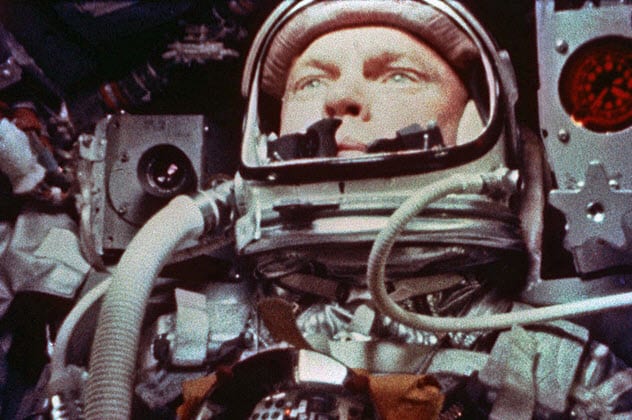
During John Glenn’s five-hour mission to space (previous US missions had only lasted 15 minutes or so), he was trained to report everything he saw. Constellations, the endless blackness, and his own condition during zero gravity were all things upon which he remarked—as expected. But he also reported on the unexpected.
During his historic Mercury spacecraft flight, he radioed to Earth:
This is Friendship Seven. I’ll try to describe what I’m in here. I am in a big mass of some very small particles that are brilliantly lit up like they’re luminescent. I never saw anything like it. They round a little. They’re coming by the capsule, and they look like little stars. A whole shower of them coming by.
They swirl around the capsule and go in front of the window, and they’re all brilliantly lighted. They probably average maybe [2.1 or 2.4 meters (7 or 8 ft) apart], but I can see them all down below me, also.
Glenn referred to these particles as “fireflies.” Future missions were given the specific task of photographing and identifying these “fireflies.”
On the next Mercury spacecraft, astronaut Scott Carpenter deduced the cause as pieces of frost escaping from the spaceship and glistening in the sunlight. A beautiful but simple mystery was solved. Still, the topic of fireflies came up once again during one of the last Mercury missions.
Astronaut Walter “Wally” Schirra reported on the fireflies: “As I said before, their source was water released in the heat exchange process that cooled our spacesuits. Another source was urine. ‘We peed all over the world,’ I’m fond of saying.”
He and his fellow astronaut took several pictures of their own pee fireflies. Schirra said, “We logged each shot with a label—urine drops at sunrise, urine drops at sunset, etc. When the photos were processed at the cape, they were beautiful and I ordered a set of prints.”
Back on Earth, the urine drop pictures were mixed in with other celestial photos. During a debriefing after the mission, Dr. Jocelyn Gill asked about the photos, “Wally, what constellation is this?”
“Jocelyn,” Schirra answered, “That’s the constellation Urion.”[6]
4 Terror: Exposure To Toxic Gas
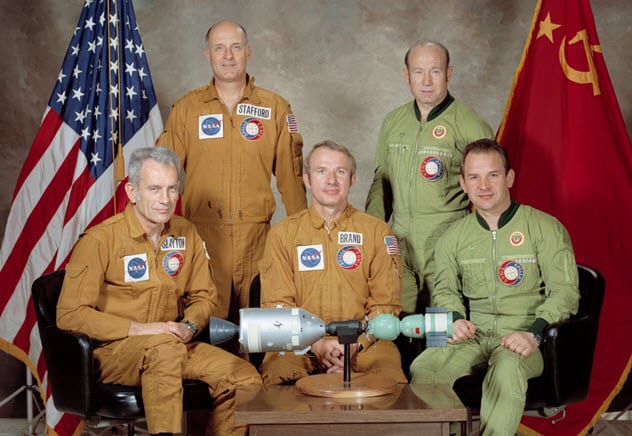
What had seemed impossible when the space race between the US and the Soviet Union began in the 1950s became a reality in 1975: The two world powers worked together and not against each other for a joint space mission.
The Apollo-Soyuz Test Project was to show that two differently designed ships could dock together in space using a jointly designed docking module. The mission was a success and offered an optimistic encounter for humanity’s future.
After the meeting of spacecraft, which included exchanging gifts in space, the two crews from two different countries went their separate ways. It was on that return journey to Earth that the US crew faced a terrifying situation.
At an altitude of roughly 7,000 meters (23,000 ft) during their descent, their cabin began filling with a brownish-yellow gas that could have been the deadly nitrogen tetroxide used for maneuvering rockets.
Astronaut Deke Slayton played it down by saying, “We picked up a little smoke on the way, and we were coughing and hacking pretty good in there.” But their exposure lasted 9–11 minutes and was enough for astronaut Vance Brand to fall unconscious.
As soon as the capsule landed, the crew rushed to retrieve oxygen masks. Brand was initially unconscious, but a readjustment of his mask was enough to wake him. The crew was rescued and given medical care.
There were no long-lasting effects, but they did suffer temporary breathing irritation. Although the mission ended with a panic, it was ultimately a successful joint mission between two longtime adversaries. Another such joint mission didn’t happen for another 20 years until the Shuttle-Mir program.[7]
3 Joy: Space Darts And Hide-And-Seek
It costs about $4,500 per kilogram ($10,000/lb) to put an item into Earth’s orbit. So luxury goods and entertainment options are limited aboard the International Space Station. Instead, astronauts sometimes need to make their own fun.
Hide-and-seek is a good game that requires nothing new sent from home. You might think that there can’t be many places to hide on a space station. But the ISS is slightly bigger than a football field and only 18.6 meters (61 ft) narrower than Star Trek’s USS Enterprise.[8]
Another “homemade” entertainment option is space darts. While normal high-speed pointy metal darts would be a very bad idea in space, a variant was designed by astronaut Chris Hadfield. Using a battery to provide weight, Velcro, zip ties, and a piece of paper acting as a feather (like an arrow), he constructed a slow-moving dart that could adhere to a target. Thus, the great game of zero-gravity darts was born.
2 Terror: Stranded In Siberia
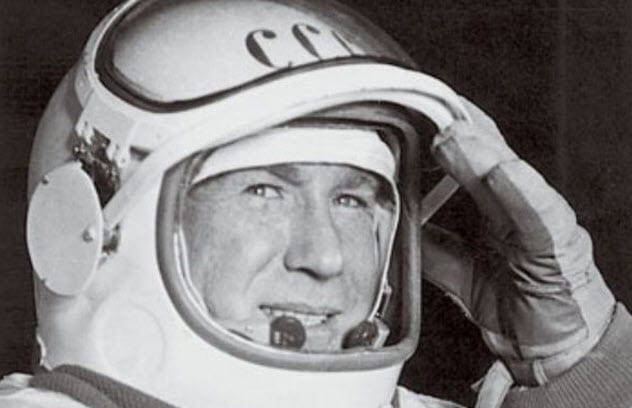
After his history-making spacewalk, the first ever performed, Alexei Leonov almost died. His spacesuit had bloated because of the unexpected conditions in the vacuum of space, and he could barely return to his craft. His only option was to bleed oxygen from his suit into space until he could once again fit into the airlock. He survived.
When he and his crewmate, Pavel (Pasha) Belyayev, later made their descent to Earth, their automatic guidance system malfunctioned. They had to guide the craft and select their destination manually.
During their descent, they once again faced possible death as their landing module remained connected to the orbital module by means of a communication cable. This twisted and spun them as they fell, forcing them into terrible g-forces that popped the blood vessels in Leonov’s eyes.
This malfunction caused them to veer massively off course. Leonov had aimed for the city of Perm and ended up 2,000 kilometers (1,245 mi) beyond it, deep in the Siberian wilderness.
Leonov wrote about the experience:
We were only too aware that the taiga where we had landed was the habitat of bears and wolves. It was spring, the mating season, when both animals are at their most aggressive. We had only one pistol aboard our spacecraft, but we had plenty of ammunition. As the sky darkened, the trees started cracking with the drop in temperature—a sound I was so familiar with from my childhood—and the wind began to howl.[9]
The temperatures reached -30 degrees Celsius (-22 °F) that first night. Leonov continued his account:
But the light was failing fast, and we realized we would not be rescued that night. We would have to fend for ourselves as best we could. As it grew darker, the temperature dropped rapidly. The sweat that had filled my spacesuit while I was trying to reenter the capsule after my spacewalk was sloshing around in my boots up to my knees. It was starting to chill me. I knew we would both risk frostbite if we did not get rid of the moisture in our suits.
The two men stripped naked to rid themselves of the moisture buildup and dismantled their spacesuits. The inner layers were soft and flexible, but the outer ones were stiff and hard and had to be discarded. They could fashion no other shelter in time and had to take refuge in the crashed capsule, which had a gaping hole where the hatch had been.
Ultimately, the two men spent two nights in the bitterly cold wilderness before being rescued. Though they faced no predators, wolves and bears were a serious enough concern that the men lobbied that future cosmonauts be equipped with more powerful firearms in case they also had to survive a wilderness crash landing.
1 Joy: The Cupola Observational Module
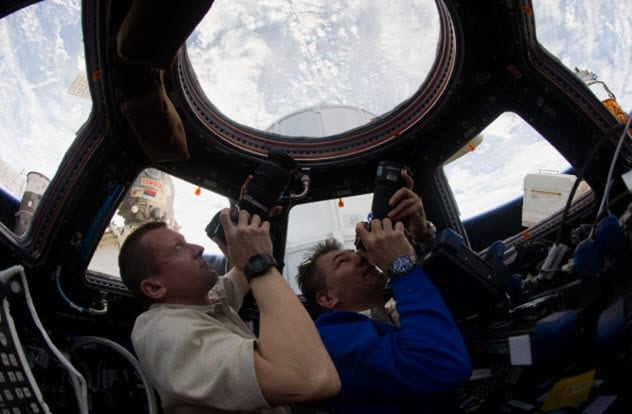
The Cupola Observational Module is a small room on the ISS. The official use is described as “for the observation of operations outside the station such as robotic activities, the approach of vehicles, and spacewalks.”
But the more popular use is as a way to behold what Chris Hadfield described as “a self-propelled art gallery of fantastic changing beauty that is the world itself.” Countless astronauts and cosmonauts from many countries have floated, mesmerized in awe at the beauty of our world.
Italian astronaut Paolo Nespoli described his time in the cupola:
I had this feeling that I was a scientist peering down a microscope that allowed me to take pictures of this small sphere rotating below, discovering microscopic things. I’d look at the pictures and realize that those things were 20 kilometers (12.4 mi) in diameter.
Alan Shepard, the first American in space, described the feeling so often felt in the cupola, although he had a different window to look out of. He said:
Instead of an intellectual search, there was suddenly a very deep gut feeling that something was different. It occurred when looking at Earth and seeing this blue-and-white planet floating there, and knowing it was orbiting the Sun, seeing that Sun, seeing it set in the background of the very deep black and velvety cosmos, seeing—rather, knowing for sure—that there was a purposefulness of flow, of energy, of time, of space in the cosmos—that it was beyond man’s rational ability to understand, that suddenly there was a nonrational way of understanding that had been beyond my previous experience.
There seems to be more to the universe than random, chaotic, purposeless movement of a collection of molecular particles. On the return trip home, gazing through [386,000 kilometers (240,000 mi)] of space toward the stars and the planet from which I had come, I suddenly experienced the universe as intelligent, loving, harmonious.[10]
Read more intriguing stories about space exploration on 10 Intriguing Space Exploration Mysteries And Secrets and 10 Crazy Ideas From The World Of Space Exploration.
